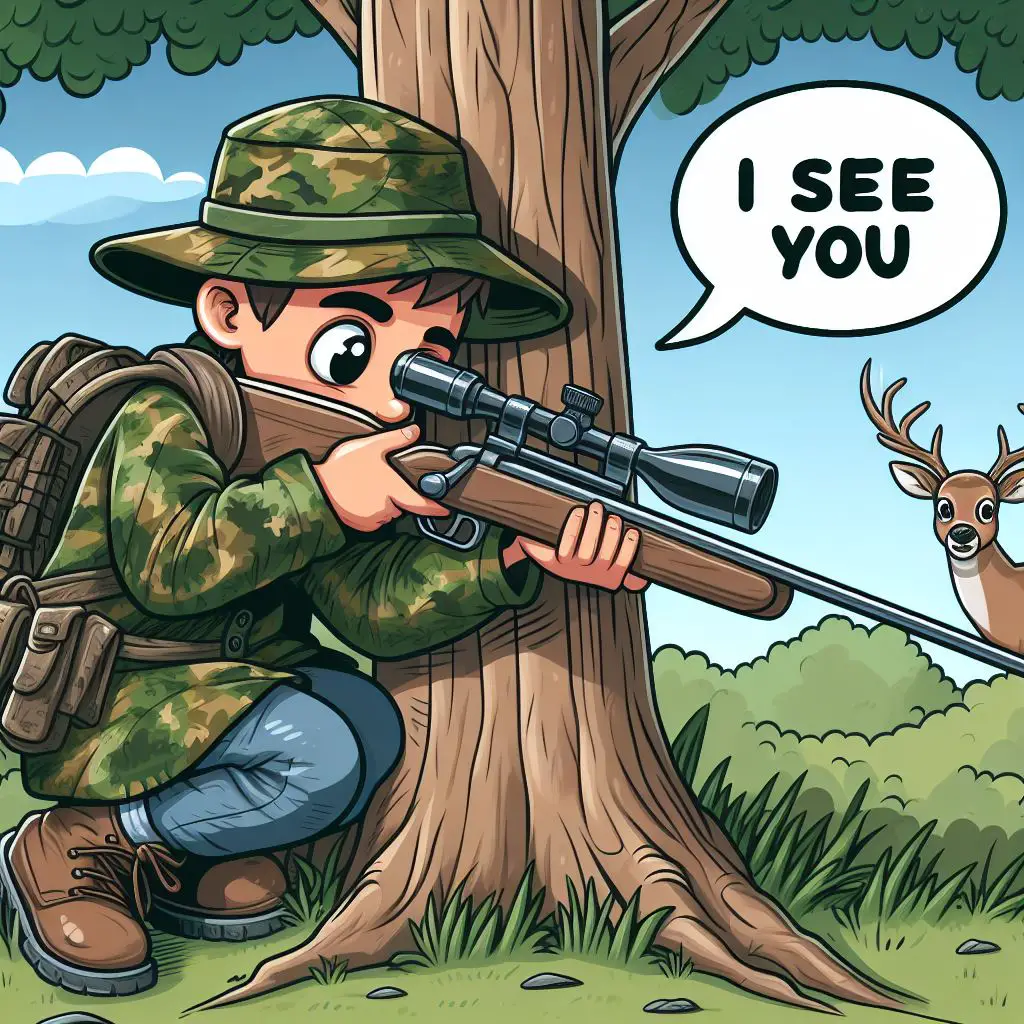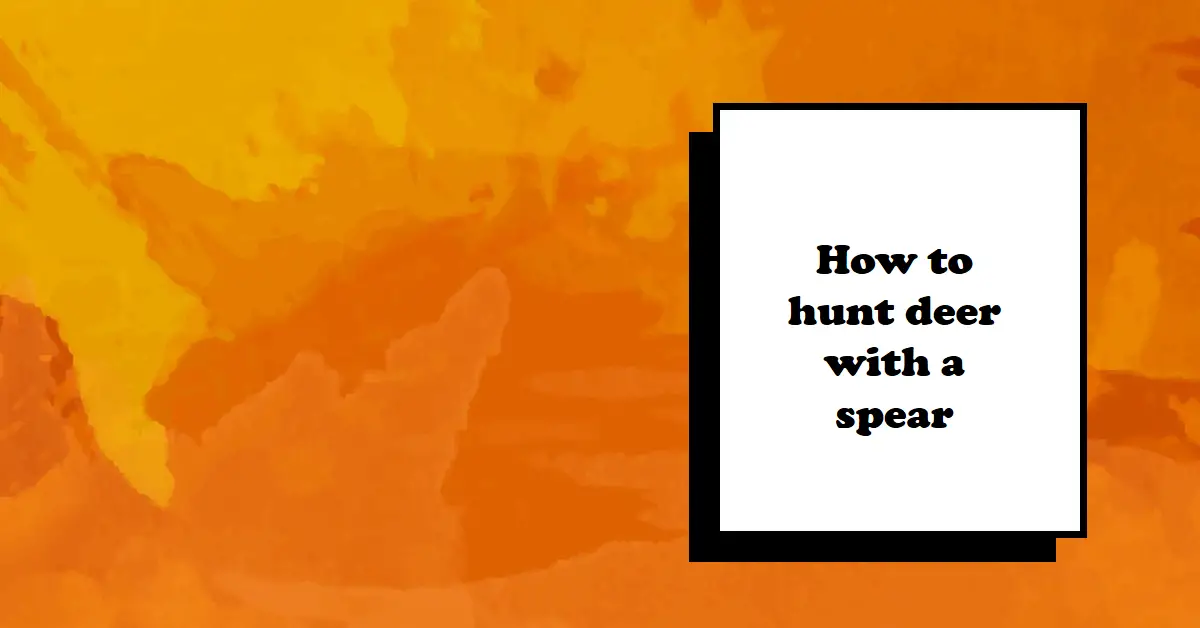Hunting deer with a spear is an extremely challenging yet rewarding traditional hunting method requiring stealth and precision. While easier tools like compound bows prevail today, spear hunting develops key tracking skills and connects you intrinsically with the hunt.
This comprehensive guide covers all the intricacies of preparing for and successfully harvesting deer using handheld spears. We explain differences between various spear types, crucial elements of strategy from tracking to delivery, and provide first-hand tips from expert spear hunters in the field.
Whether using throwing spears, controlled stalking hunts, or concealed ground blinds to ambush prey, this detail-rich walkthrough outlines the exhilarating experience of taking down deer with one well-placed thrust of a spear. Let’s get started!
Is Spear Hunting Deer Legal?

Before anything else, be sure spears are legal for deer hunting depending on season rules and weapon classifications for your region. Regulations often group spears under “primitive arms” or “edged weapons” categories covered by special seasons. Some states even restrict range distances and require blade width minimums when using hand spears.
Always check state hunting guides for specifics around spear usage, protective equipment rules, tagging/processing protocols when harvesting with spears and other facets governing their legality. Having this administrative foundation ensures smooth compliance spearing deer in your area.
Types of Spears – Features and Tradeoffs

If legal in your state, next comes selecting the best style spear for effectively striking and recovering deer based on your preferences and terrain. Various spear types and designs factor which work differently in given situations.
Popular options include:
Throwing Spear
- Launched from standoff distance towards target
- Require practice achieving accuracy
- Effective range around 20 yards max
- Must track deer after landing strike
Stalking Spear
- Used in close range, sneak ambush attacks
- Get extremely close to thrust spear
- Small concealable size
- Retains spear while deer retreats
Two-Handed Boar Spear
- Long heavy two-handed spear
- Powerful piercing penetration
- Often used with dogs holding prey
- Short range ambush tool
Trident Spear
- 3 parallel blades on spearhead
- Creates wide injury channel
- Less likely to fully penetrate
- Higher probability of contacting vital organ
Winged Slash Spear
- Perpendicular blades or “wings” out sideways
- Cuts broad wound channel
- Designed to slice veins/arteries
- Deer bleeds out quickly
Depending on your personal preferences, terrain constraints, planned hunting style and anticipated distances from deer, select the spear type aligning closest to hunt requirements.
Now let’s overview crucial elements to address when preparation phase before engaging in an actual spear deer hunt.
Preparing for a Successful Spear Hunt

Hunting deer with basic spears requires extensive preparations validating you can place your piercing tip exactly in a lethal organ area as opportunities appear fleetingly. Here are key areas to train:
Accuracy & Rangefinding Practice
- Establish realistic max distance for your spear type
- Drill repeatedly from set distances until hitting bullseye consistently
- Practice from various angles/positions
- Use target debris to gauge penetration potential
Tracking & Stalking Skills
- Train spotting deer subtly moving through brush without spooking
- Master seamlessly crouching low through woods without snapping twigs
- Refine patience waiting motionless for clean opportunities
Physical Fitness & Mobility
- Running, cardio for rapid positioning as deer flee after strike
- Core, shoulders, arms, grip for powerful thrusts
- Flexibility for contorted positions masking scent
Mental Preparedness
- Meditate deeply visualizing delivering perfect spear blows
- Clear all doubt or hesitation for decisively taking killing shots
With extensive repetition ingraining accuracy, stealth movements, patience and killing intent, your confidence will grow immensely heading out to actively hunt deer with spears on location.
Now let’s explore elements of actively tracking and taking down deer once embarked on a live spear hunt.
Locating and Stalking Deer for Strike Setup

The challenge begins by intersecting paths with a huntable deer without detection while maintaining enough proximity for delivering a killing spear thrust.
Tracking Wild Deer Movements
- Learn deer trails they use moving between bedding and feeding areas
- Identify game runways used traveling through terrain features
- Note weather and feeding patterns governing deer activity
- Plan approach accounting for predominant wind direction
Silent Stalking Strategies
- Remain downwind using airs movement to hide scent approach
- Master smooth gait walking softly along forest floor without snapping sticks
- Use terrain masking moving stealthily between boulders/trees
- Carry gear preventing metallic clinking sounds giveaway
Optimizing Strike Range Distances
10-15 Yards – Ideal for expert spear hunters allowing reaction time parrying initial reflex charge or bolt attempt by deer.
5 yards – Minimum for novice hunters requiring nearly point blank positioning before confidently striking vital area.
20+ yards – Maximum for experienced hunters with years deeply attuning to specific spear throwing ballistics and deer anatomy familiarity.
Adjust your setup distance from deer depending on skill level, spear type and ability judging explosively fast deer movements after initially wounding with spear strike.
Now let’s detail the most effective spear placement targeting vital kill zones on deer…
Striking the Vital Targets for a Clean Kill

With deer positioned optimally nearby, next comes surgically identifying and piercing specific anatomical weak points for the highest probability of instantly incapacitating prey:
Heart & Lung Core (Best Odds for Clean Kill)
The heart and lungs reside low-center in the deer’s chest, presenting the largest vital area target to aim your spearing tip. Penetrating this organ group with the spear length disrupts essential circulation and respiration functions quickly.
Precise Aim Points:
- Heart – Rear center of front leg pocket low on chest
- Lungs – Broad zone behind front shoulders spanning chest
Neck Artery Bundle (Riskier but Rapid Bleedout)
A precisely placed spear severing the esophagus and carotid arteries in the neck can also take down deer lethally. However, the smaller target area raises risk of non-fatal flesh wounds.
Exact Aim Point:
- Carotids/Esophagus – Upper centerline of neck approximate with head base
Consider aiming for neck only when unavoidably detected directly facing deer head-on at close range with no room repositioning for larger chest targets.
Executing an Effective Spear Thrust

With prey positioned in the selected strike zone, executing an efficient piercing spear thrust involves forcibly driving the very sharpest blade tip through the anatomical weak point for maximum penetration depth.
- Hold spear just behind the head placing dominant hand nearest blade end for added force
- Pull spear arm back to full extension without compromising balance
- Lean weight over embedded front foot keeping shaft horizontal at deer body height
- Explosively drive legs and hip rotation adding momentum striking the precise anatomical mark
- Maintain spear direction control resisting tendency for shaft to warp on contact
- Apply full body mass heaving spearhead completely through deer for pass-through emergence
Proper spear thrust technique exponentially amplifies odds immediately dropping prey at the moment of first injury contact.
After Strike – Tracking & Recovering Your Kill
Upon solid spear impact, the final challenge comes tracking and recovering your wounded deer before loss or expiration.
Assume the deer will immediately:
- Bolt explosively for 75-100 yards unless spine severed
- Seek dense cover to escape and laydown
- Attempt circling back making recovery challenging
Track Strategies to Locate Your Kill:
- Visually identify precise injury location on deer observing initial bolt direction
- Scan blood speckled vegetation tracing escape path direction
- Listen for sounds of thrashing movement in nearby cover
- Avoid spooking deer by prematurely approaching laydown location
- Carry replacement spear when closing in case follow up thrust required
Meticulously tracking the blood trail brings you to the expired carcass site for harvest transport preparation. Prior proper planning expedites safe extraction minimizing meat damage while complying with local game department protocols.
As you gain firsthand spear hunting experience, incorporate lessons learned to refine and improve methodology. Now equipped with comprehensive understanding of integral considerations pursuing deer through primitive hunting methods, your journey culminating at the kill site proves infinitely more rewarding having intimately participated across the entirety of the process!
Key Takeaways – Hunting Deer with Spears
- Confirm regional legality and seasons for spear deer hunting
- Select ideal spear type fitting your skills and hunting terrain style
- Extensively practice vital organ accuracy from optimal range
- Attain supreme stealth and tracking capabilities

